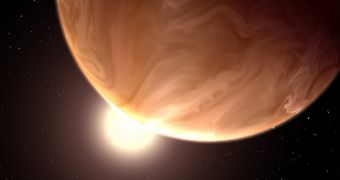According to the conclusions of a new study conducted with the NASA/ESA Hubble Space Telescope, it would appear that planets belonging to two of the most common classes of extrasolar worlds in the Universe may be blanketed in clouds.
The research team established that both exoplanets studied by Hubble featured thick atmospheres that contained a lot of clouds. In fact, it is entirely possible that these worlds have a lot more clouds than even the sensitive telescope was able to determine, due to the vast distanced involved.
Though Hubble will turn 23 this year, its instruments were last replaced or serviced in 2009, when space shuttle Atlantis carried out Servicing Mission 4 to Hubble. This upgrade enabled the observatory to remain relevant for the type of studies being conducted in exoplanetary research today.
Its sensitive instruments were able to characterize the atmospheres of the two nearby worlds. Astronomers with the California Institute of Technology (Caltech), in Pasadena, California, led by expert Heather Knutson, determined that extensive cloud blankets exist on both planets.
The worlds are called GJ 436b and GJ 1214b, and are located 36 light-years, and 40 light-years away from Earth, respectively, in the direction of the constellation Ophiuchus. Details of the study appear in two papers published in the January 2 issue of the top scientific journal Nature.
GJ 436b is cataloged as a warm Neptune, a world the size of our solar system's ice giants, which is smaller than gas giants such as Jupiter, but larger than smaller, rocky worlds such as Earth.
GJ 1214b, on the other hand, is a super-Earth, meaning it is much closer in diameter and mass to our planet than Neptune. The atmospheres around both these worlds eluded accurate description until now.
“Either [GJ 436b] has a high cloud layer obscuring the view, or it has a cloud-free atmosphere that is deficient in hydrogen, which would make it very unlike Neptune,” Knutson explains.
“Instead of hydrogen, it could have relatively large amounts of heavier molecules such as water vapor, carbon monoxide, and carbon dioxide, which would compress the atmosphere and make it hard for us to detect any chemical signatures,” the Caltech team leader explains.
The paper on GJ 1214b was published by astronomers at the University of Chicago. The team was led by experts Laura Kreidberg and Jacob Bean, who also used Hubble data for their investigation.
“Both planets are telling us something about the diversity of planet types that occur outside of our own solar system; in this case we are discovering we may not know them as well as we thought,” Knutson concludes.

 14 DAY TRIAL //
14 DAY TRIAL //